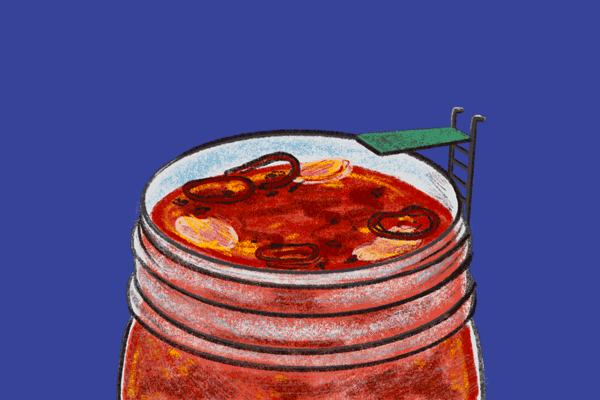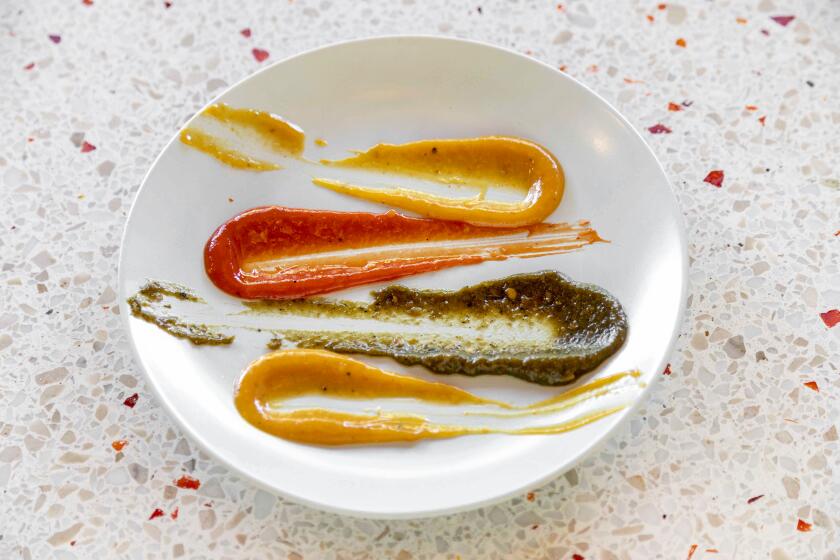L.A. is in the middle of a chile sauce craze. 16 to try now
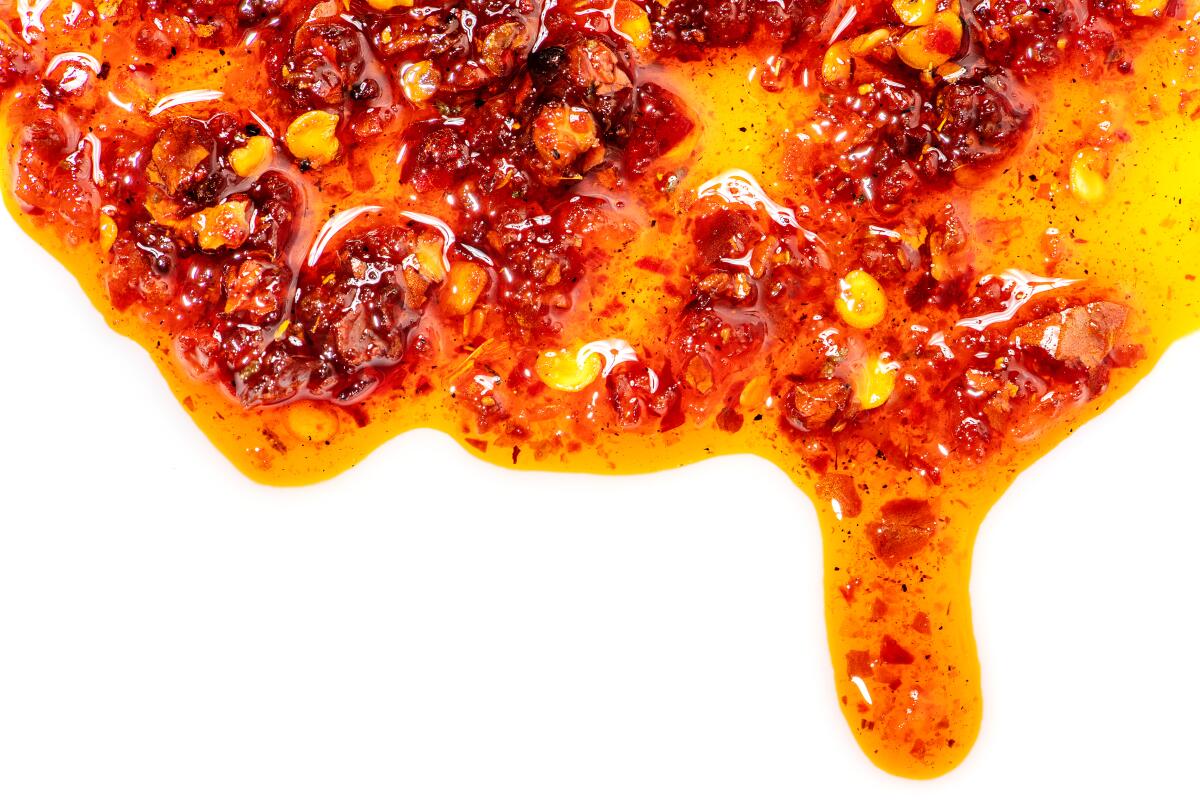
- Share via
In February 2015, in a tiny ramen-ya in the Far East Plaza in Chinatown, Jonathan Gold led a hot sauce taste-off with chefs Roy Choi and Alvin Cailan. They assembled an array of fiery condiments, including hometown favorite Sriracha and bottles of Cholula, Tapatío, Tabasco and sambal oelek. At the last minute, I introduced a bottle of Lao Gan Ma Spicy Chili Crisp to the mix.
I watched as the three men dunked a series of pink plastic spoons into the sauces. They sampled the condiments, squinting their eyes and pursing their lips. After all the bottles had been considered, it was the Lao Gan Ma that won over all of them.
Lao Gan Ma, the gold standard of chile sauces, was created in 1984 in Guizhou, China, by Tao Huabi. Hers is the face that stares back at you on the label. For many years I called it the “sauce with the stern lady” (she is not smiling in the photo).
It’s a sludgy mix of oil, fermented soybeans, dried chiles, crispy onions and MSG. It’s not so much a condiment as it is a composed dish you can eat on a spoon, with an intense, sweet onion aroma and a plethora of textures and spices. It’s so popular in China that tourists often travel with their own bottles.
Wee Chi Li, who co-owns the America Asia Travel Center, a travel agency in Los Angeles, works primarily with tourists from Asia and can attest to the condiment’s popularity. He started seeing visitors from mainland China bringing bottles of Lao Gan Ma to Los Angeles about 20 years ago, especially those from Hunan or Sichuan, two areas known for spice-heavy foods.
“When they come to the States, they bring it so that no matter what they are eating, they can add some flavor to enhance the food,” he said.
You can find a jar of chili oil on the tables at countless restaurants and noodle shops in the San Gabriel Valley, but in the last two years, Los Angeles has experienced achile sauce revolution. Local chefs and entrepreneurs have created at least 16 versions of chili crisp and chili oil, and the majority have popped up in the last year.
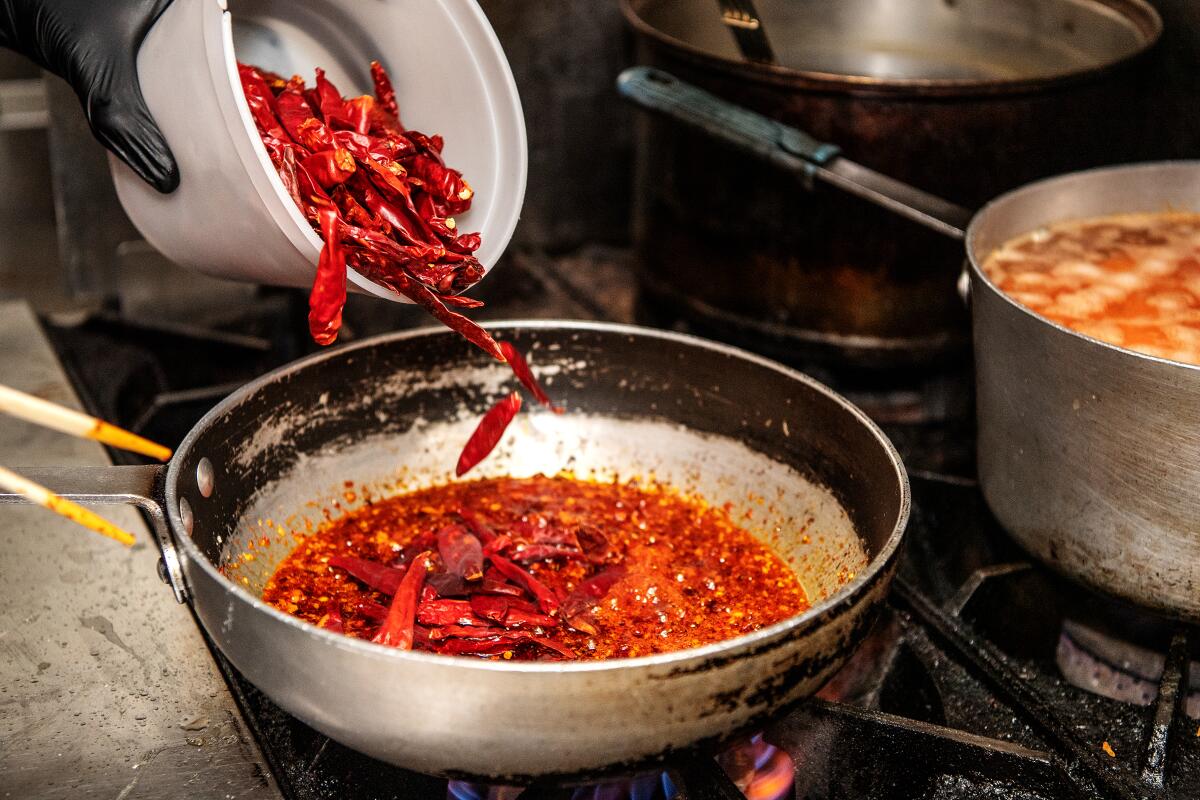
The recent wave of product can be attributed in part to chefs and restaurateurs nostalgic for flavors they experienced in the past, the rise of entrepreneurial thinking during the pandemic, and a growing acceptance and need among diners for a hot sauce that is aggressive in both texture and flavors.
Susan and Mike Wong, who started selling the Bits Chili Oil on Instagram in February, believe the pandemic helped prompt the recent surge in popularity.
“I think that especially during the pandemic, a lot of people cooking at home need anything possible to amp up their cooking game,” Susan said. “Maybe they are not wanting to buy the same things, and they are getting more adventurous with buying food products on social media.”
While chili oil, typically made by pouring hot oil over chiles and aromatics to create a sauce, has been popular in China for decades, the Western world started paying attention after the success of Lao Gan Ma. The company reported $835.6 million in sales revenue in 2020.
This homemade chili crisp recipe inspired by Lao Gan Ma Chili Crisp is the best condiment. It’s savory, crunchy, oily, spiced but not too spicy.
Some of the newer entrepreneurs refer to their chile sauces as chili oil; others call it chili crisp, which is what you get when the chiles and aromatics such as onions and garlic crisp up during the process. Maggie Zhu, a chef and author from Beijing, says chili oil and chili crisp are not technically the same but that there really isn’t a separation of the two concepts in China.
“They both fall under the ‘hot sauce’ category, and there is a spectrum of them in terms of texture and ingredients,” she said.
In China, Zhu says people refer to chili crisp as chile sauce or Lao Gan Ma. And the styles can vary based on the region. “Sometimes it’s blended with fermented black beans,” she says. “If you go down into more coastal areas in the southern part, sometimes they add dried fish or fish paste.”
Jing Gao, a chef and entrepreneur, developed one of the first of the new generation of chile sauces, Fly by Jing Sichuan Chili Crisp. She created the sauce as part of a supper club she started in Shanghai and started bottling and selling the sauce there in 2018. Later that year, she visited the Expo West food show in Anaheim to see what else was on the hot sauce market.
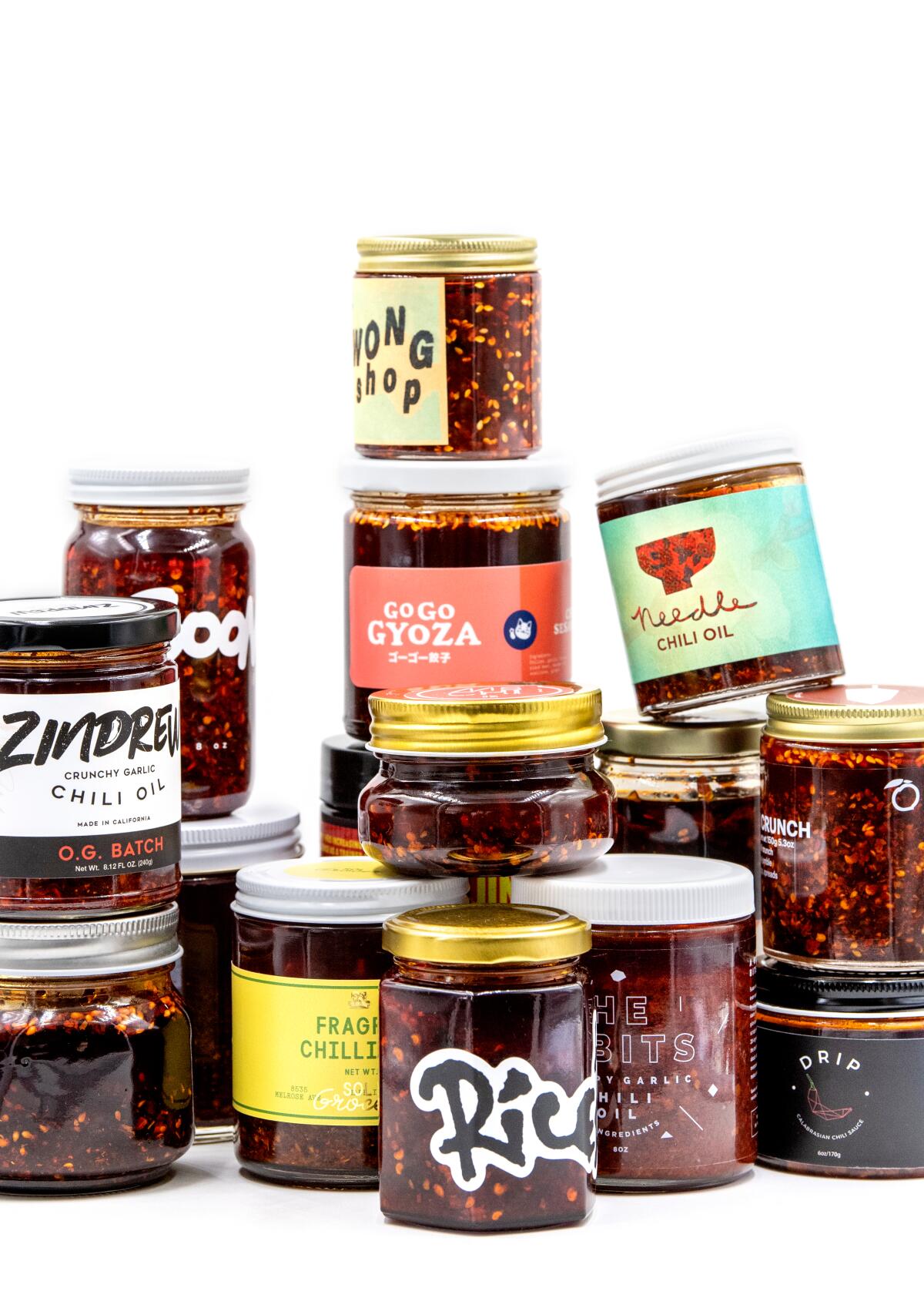
“I was really shocked to see there was practically no Asian representation in any of the foods,” she said. “That’s when I said I really need to bring this to the U.S. and address some of these false narratives about Chinese food and the culture and the people.”
Gao sources her ingredients from Sichuan, including Erjingtiao chiles, Sichuan peppers and a variety of mushrooms. She believes the success of Fly by Jing, a brand that now includes two sauces, a spice mix and other pantry items, has helped fuel the recent chile sauce craze.
Los Angeles chef Wendy Mattick recently launched the Red Oil Collective, a limited edition box of five chili oils made by Asian American Angelenos, after the Atlanta-area spa shootings. The $100 box includes chili oil from Mei Lin (Daybird), Ryan Wong (Needle), Max and Wendi Boonthanakit (Boon sauce), Juliana Hung (the Wax Apple) and Mattick and her husband, Jason. The proceeds will benefit the Los Angeles branch of Advancing Justice, a civil rights organization for Asian American, Native Hawaiian and Pacific Islander communities.
The Matticks made their sauce, called Addy sauce, specifically to contribute to the box. They used ingredients they already had in their pantry, such as fermented black bean, Korean chile flakes and a Thai spice blend called prik larb muang. For now, it will be available only in the Red Oil Collective box, but Wendy Mattick said they plan to make more.
She believes the recent chile sauce boom can be attributed to factors such as the convenience of selling and buying products on Instagram and an almost universal love of spicy foods.
“Almost every Chinese person has some sort of chile sauce in their fridge,” Mattick said.
Hung, who is represented in the Red Oil Collective box, started making her chile sauce when she was hosting dinners and cooking workshops about three years ago. After the start of the pandemic, Hung sold jars of her sauce on SoonMini, an online store devoted to products from local farmers and artisans such as small-batch kimchi and jams. She also offered jars of the sauce as part of a weekly food pickup business she created in May 2020 via the Mini Mart online storefront.
“I think the first-generation and second-generation immigrants are really pushing our food forward, and we’re doing things that we grew up with but presenting it in a style that’s not intimidating,” Hung said. “In L.A., there is an emphasis on well-made, thoughtful Taiwanese and Chinese food and with that, people are able to dissect the dishes and are more interested.”
The sauces:
Fly by Jing Sichuan chili crisp, $15
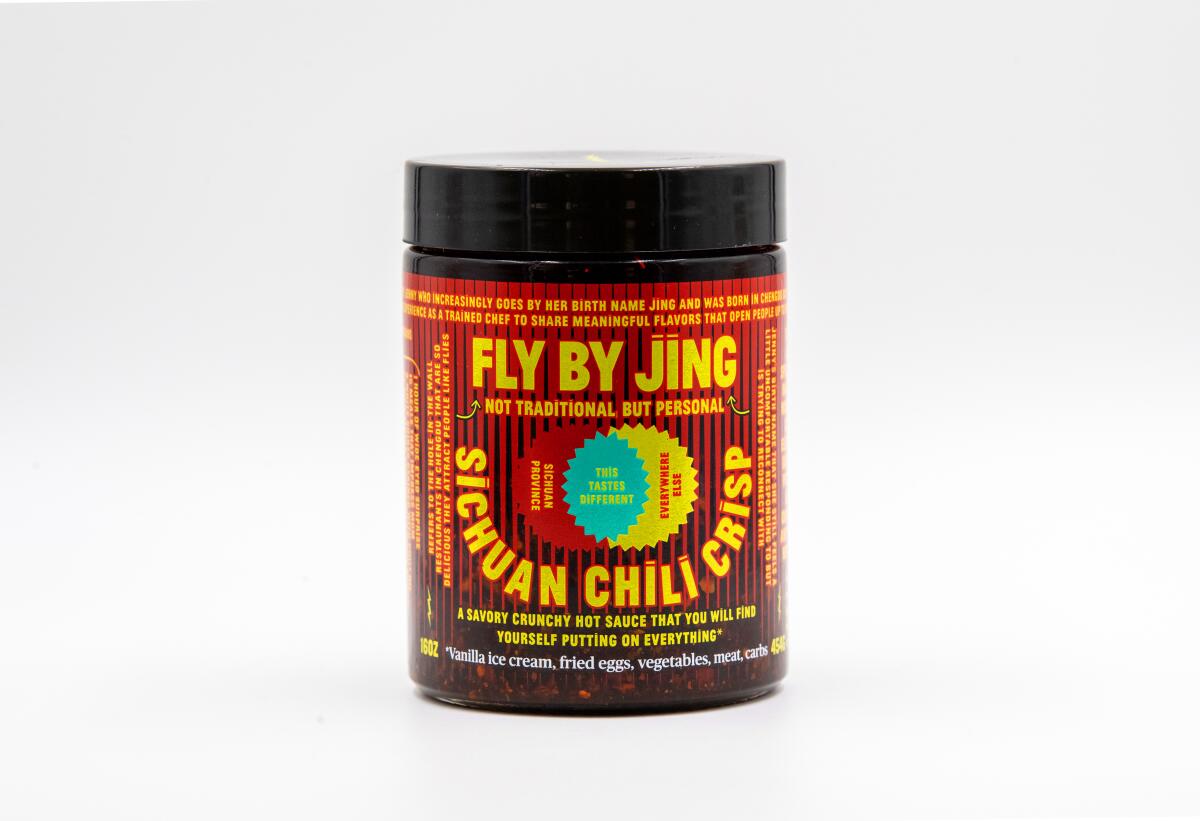
You can eat Jing Gao’s Sichuan chili crisp straight from the jar with a spoon — the best way to fully experience each ingredient and flavor, which changes depending on the bite. The consistency most resembles day-old mud, and it’s a deep red that’s almost black — the color of the vampire blood in my favorite movies. It’s a thick, heady, earthy sauce with whole, chewy black beans. The ginger is hot and pungent; the seaweed, sweet and briny. The mala from the Sichuan pepper is present but not overwhelming, and the mushroom powder fortifies the rapeseed oil, giving every drop a slap of umami. (Gao was the catalyst for multiple articles and Instagram photos featuring hot sauce dripping down scoops of vanilla ice cream. I’d recommend the vanilla, though a spoonful does wonders on a scoop of peanut butter ice cream too.)
Go Go Gyoza Sesame Chili Oil, $8.50
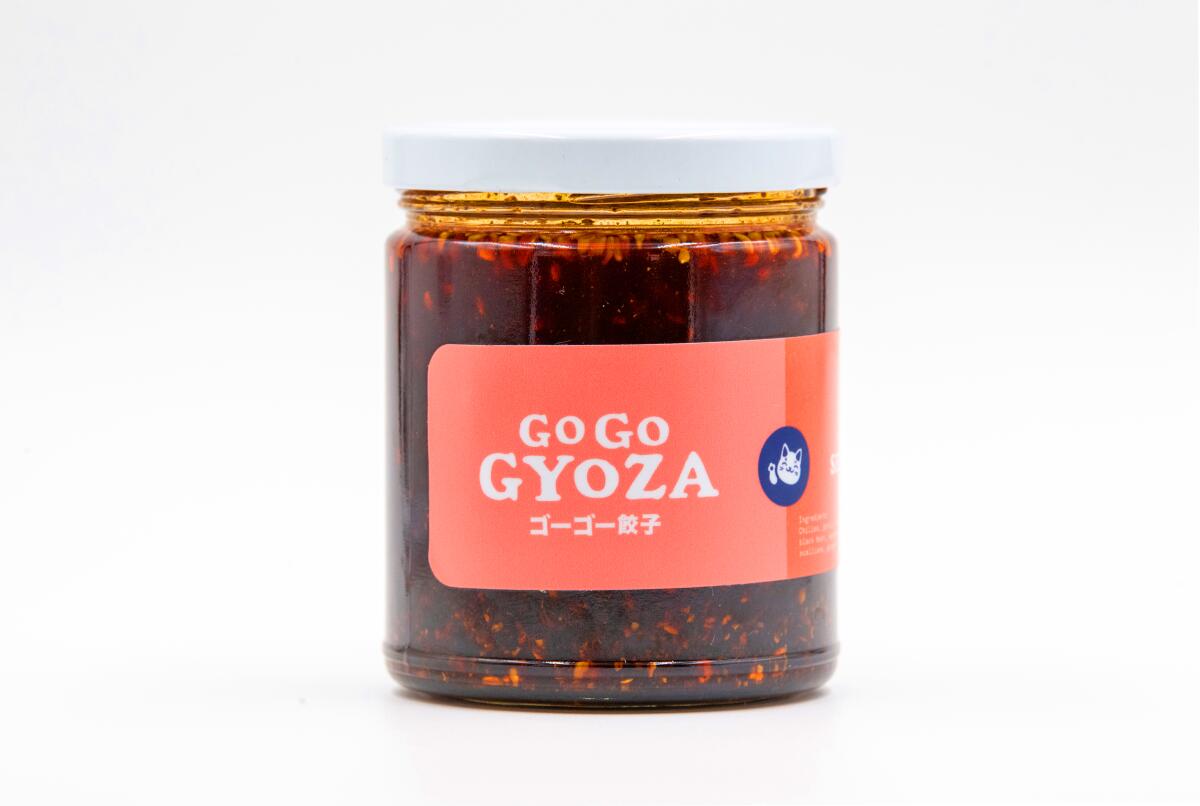
Last April, Hinoki & the Bird executive chef Brandon Kida launched a frozen-dumpling delivery service called Go Go Gyoza. He created what he calls a “California Chinese-style” chili oil to pair with the dumplings. There was often a two-week waitlist for the gyoza, and Kida’s customers frequently requested extra chili oil. The sauce is a loose oil with a short layer of sandy ground guajillo and Japones chiles and garlic at the bottom and whole sesame seeds floating near the top. It smells strongly of star anise and onion. He uses both green and red peppercorns and lots of black pepper, and the fermented black beans give the sauce an umami backbone. The sauce adds more spice than heat, coming in at a 3 out of 10. It’s a luxurious oil that’s excellent on Kida’s dumplings as well as the fried chicken he makes for his other pop-up, Go Go Bird. But the chef’s favorite pairing for his sauce happens to be a classic Italian Bolognese.
Kwong Shop Chili Crisp No. 5, $12
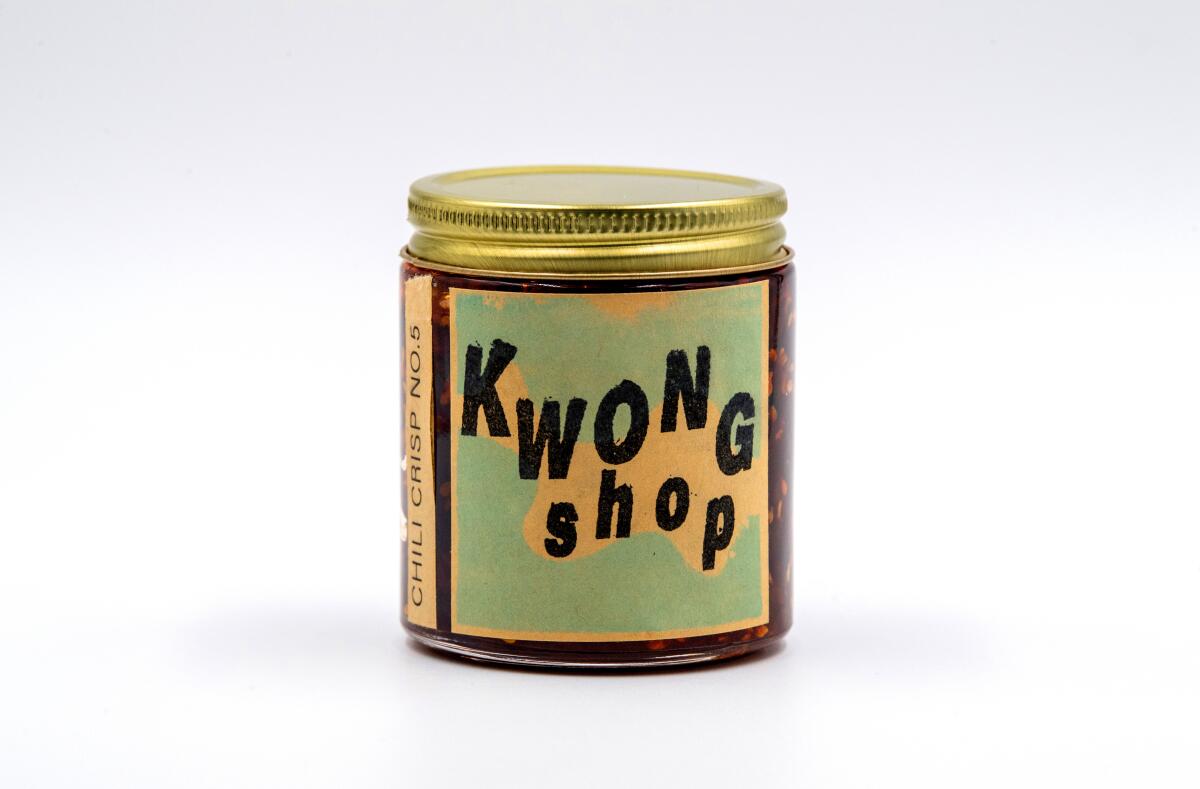
Jenn Kwong spent much of her childhood in her parents’ three restaurants in Cincinnati, Ohio. Her father would bring home massive metal bowls full of noodles and a large foam cup of his chili crisp. Eventually, she made her way to Los Angeles. After she lost her job as a fashion designer during the pandemic, Kwong reconnected with her love of cooking by making her own chili crisp. She sources her ingredients, including fresh chiles de arbol, from local farmers markets. She toasts the chiles, grinds them with a mortar and pestle, and infuses her oil with heaps of chopped garlic, shallots and spices for hours. She calls it “extremely small batch” and makes only about 15 4-ounce jars at a time. The sauce is jammy, with the smallest bit of oil pooled at the top, and there are rough chunks of chile and whole sesame seeds. Of all the ingredients, the shallot and garlic shine through, with a heat level that hovers around a 5 out of 10.
Hui Tou Xiang chili oil, $5

Jack Li’s mother, Lucy Guo, started making chili oil for their San Gabriel restaurant Hui Tou Xiang five years ago. Li says they used to buy the oil but it was expensive in large quantities, and his mother could make a much better version. The family started selling jars of the oil last year after customers requested bigger servings with their takeout orders, giving Li an extra source of income during the pandemic. The Hui Tou Xiang chili oil is made with big tubs of soy oil, infused with cinnamon, brown onion, green onion, star anise and ground raw chiles that cook in the hot oil. The sauce has a sharp toasted-chile aroma and flavor with faint hints of the other spices. If you want an oil that tastes of pure chile but won’t destroy you (the heat level is about a 5 out of 10), this is it.
Needle Chili Oil, $10
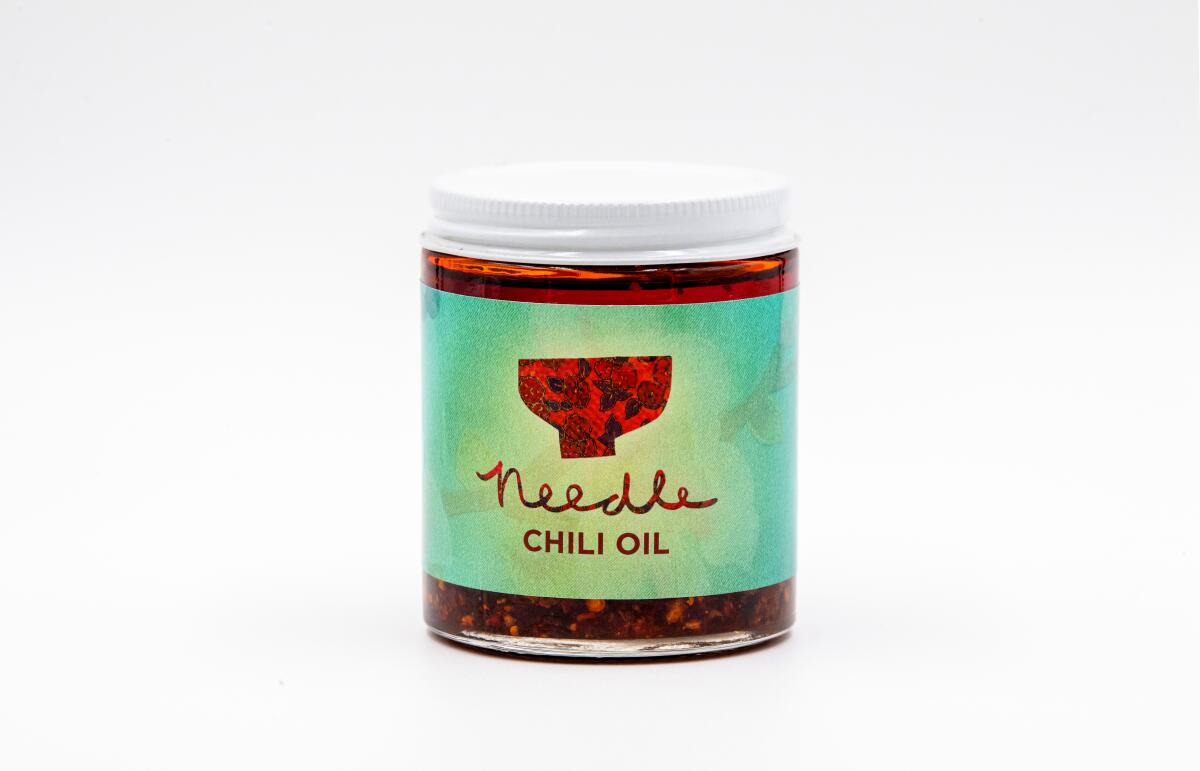
The chili oil at Ryan Wong’s Silver Lake restaurant has a shrimpy funk that reminds me of XO sauce. It’s more oil than sediment, so it never really creates a cohesive sauce and just sort of drips, slides and seeps into the endless heaps of fried rice I put it on. Wong started making his oil about five years ago for a noodle pop-up he was working on in Los Angeles. He wanted to create something close to the chili oils he enjoyed during his travels throughout Hong Kong (his favorites often included dried shrimp). Wong brings a mix of peanut and canola oils to not quite smoking and then adds fresh Fresno chiles, garlic and shallot. The toasted quality of Sichuan peppers helps balance the fruity Fresnos, and dried shrimp give it a signature funk. Expect a heat level of about 6 out of 10.
Drip, $20
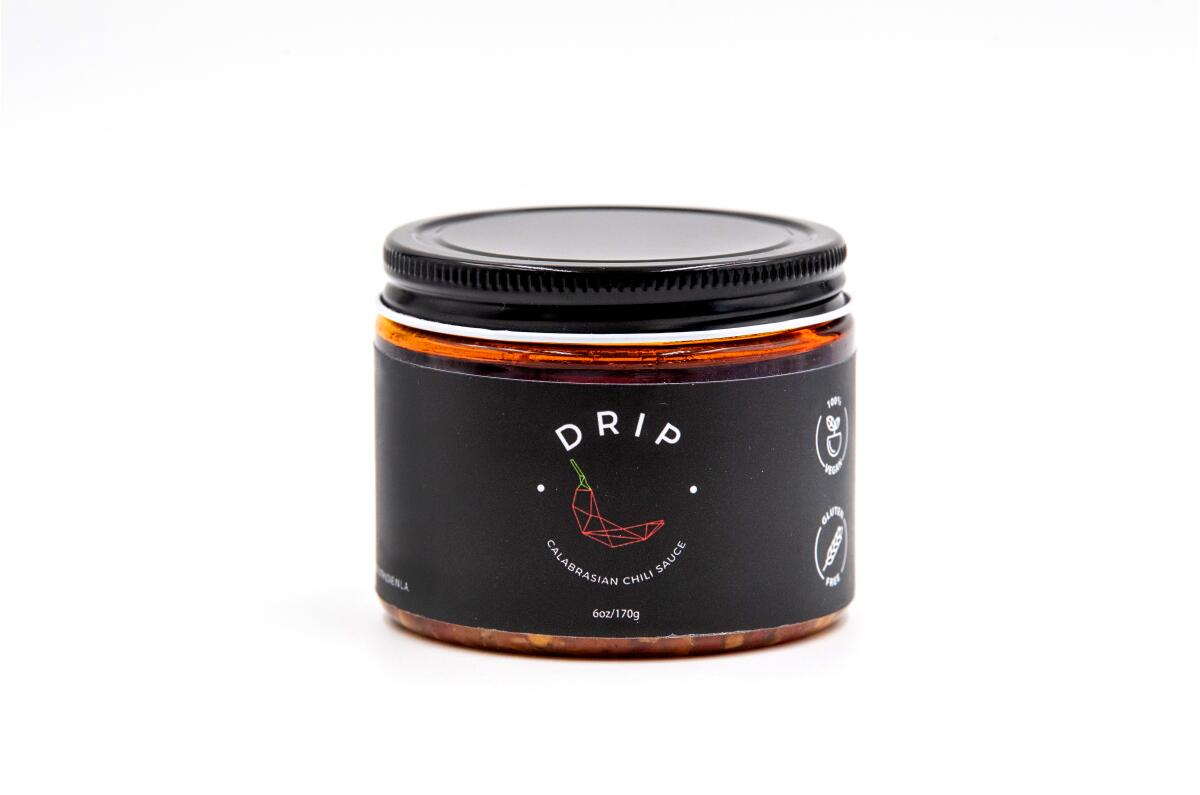
Chef Tony Nguyen says he started making Drip sauce to raise some money for his upcoming wedding. The chef at AnQi at South Coast Plaza had experimented with hot sauces for several years, and that experience turned out to be useful when the restaurant closed during the pandemic and he had some extra time on his hands. Instead of doing a straight riff on Lao Gan Ma, one of his favorite hot sauces, he merged his love of chili crisp with his fondness for Calabrian chiles, often used in Italian cuisine. Drip sauce is a combination of Thai bird chiles and a variety of Chinese peppers that Nguyen sun-dries himself. He also uses three forms of Calabrian chiles: dried flakes, dehydrated powder and whole peppers packed in oil. The sauce gets a heavy dose of fried garlic and some honey, which curtail the heat to a 3 out of 10. It’s more of a chile paste with oil at the top, and Nguyen tells customers to scoop the sauce as is, so that you almost get two sauces in one. “We called it Drip,” he said, “because the oil drips everywhere.”
Sbez Hot Sauce delivers deep flavor thanks to charred peppers, blistered garlic and cheffy infusions of seasonal fresh fruit. What started as a passing interest years ago became a lifeline during the pandemic.
Umamei chili oil, $18
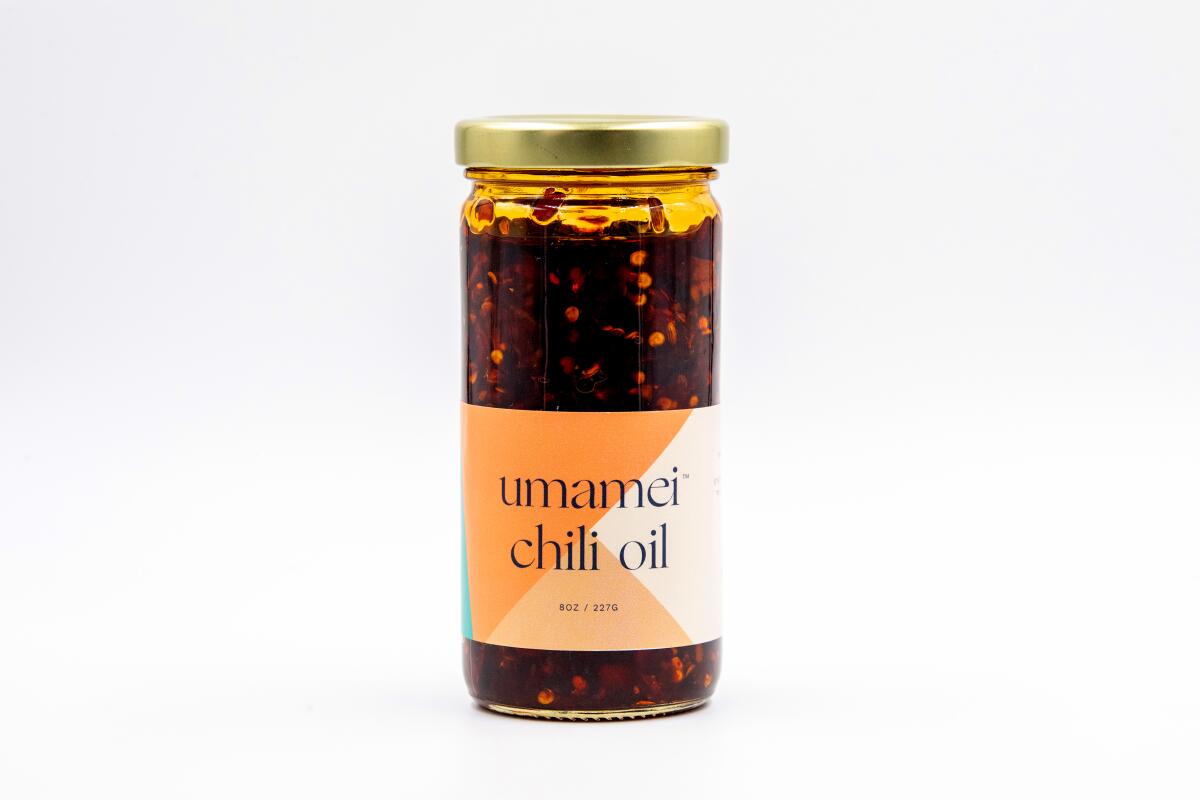
You can feel Mei Lin’s chili oil at the base of your nose. The heat storms your senses and wraps around your head before it mellows and the nuances in flavor start to become apparent. . That intense heat comes from chiles de arbol, Japones and Yunnan chiles and Gochugaru. Lin, who is the chef-owner of Sichuan hot-chicken restaurant Daybird, balances the heat with a good amount of sugar and whole fennel seeds. “It’s not like Lao Gan Ma,” Lin said. “It’s more jammy because there is quite a bit of sugar in each batch.” The chef started making chili oil and XO sauce as gifts for friends in 2013 and started selling her sauce in 2018. She suggests using the sauce to amp up any dish that needs a kick (it’s a 7 or 8 out of 10). “My favorite thing to put it on is probably takeout curry, dumplings and noodles,” she said.
Momofuku Chili Crunch, $12
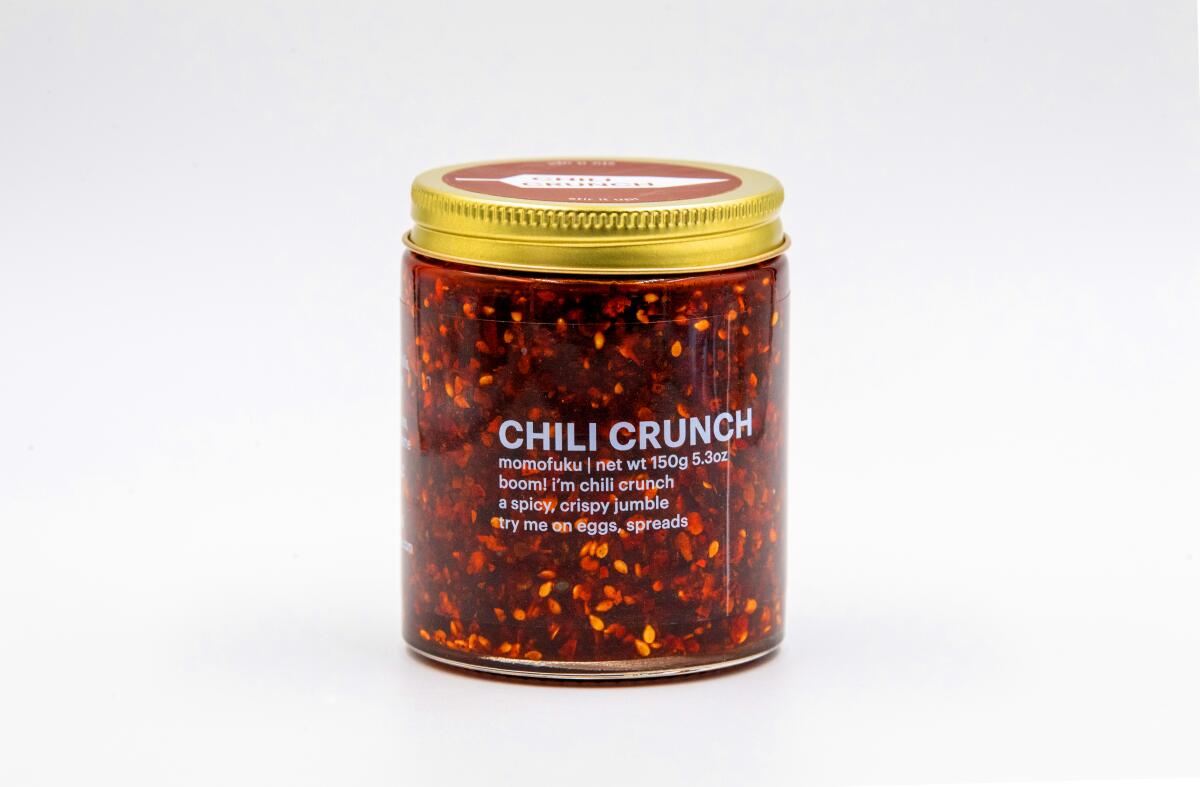
As a kid, David Chang loved the vinegary, oily chile sauces from restaurants like Wu’s Garden and Peking Gourmet Inn in Virginia, where he grew up. When he moved to New York, he ate copious amounts of Lao Gan Ma, and when he started serving roast duck at his restaurant Ssam Bar, he made his own version of chili crisp to serve with it. The current iteration is something he’s been working on for 10 years, influenced by that original Ssam Bar sauce, a version he made in Copenhagen using chiles from chef Rosio Sanchez and a salsa seca at his Los Angeles restaurant Majordomo that was inspired by Eastside Tacos in L.A. The sauce has a pronounced toasted-seaweed flavor with a hint of sweetness that rolls into a wave of heat and sesame and finishes with a lingering crash of garlic. It’s the crunchiest, chunkiest sauce I tried, with a heat level of about 6 out of 10.
shop.momofuku.com/products/chili-crunch
Boon sauce, $18
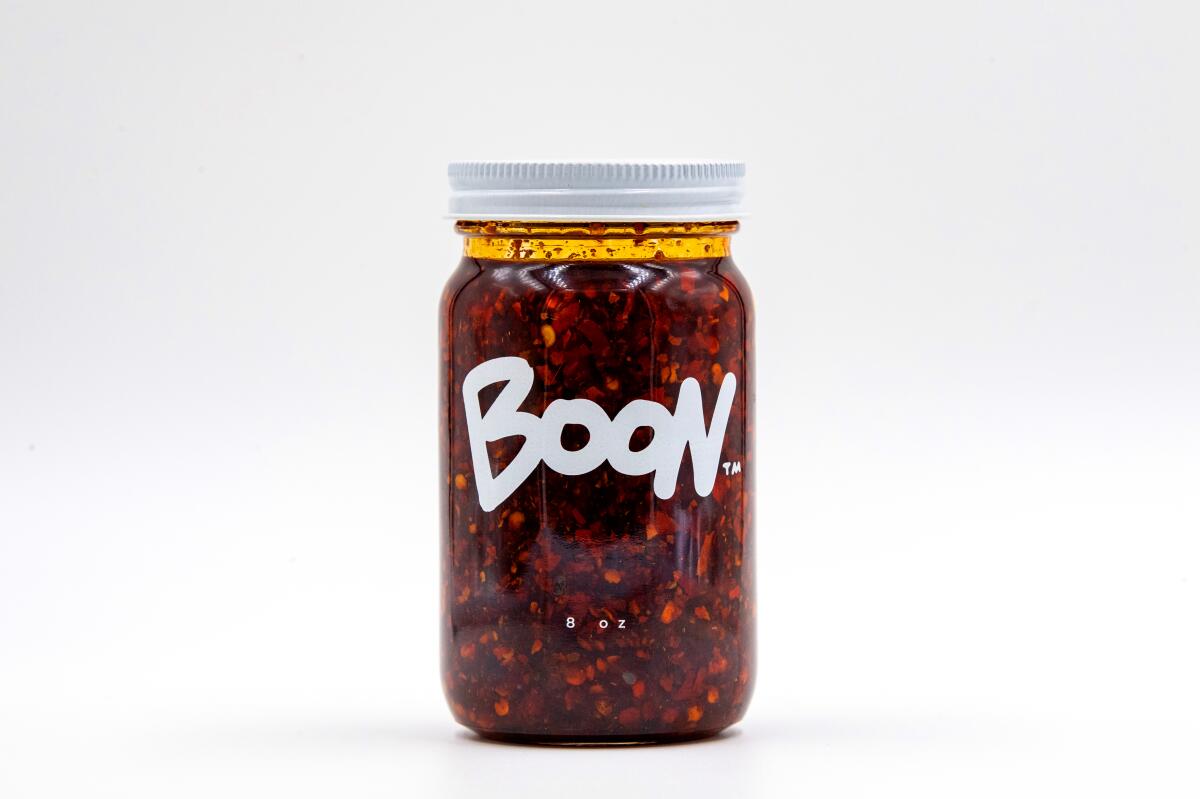
In 2015, Max Boonthanakit was between restaurant jobs and had just finished what he believed was his eighth jar of Lao Gan Ma. Boonthanakit, who has cooked at Nightshade, Kato and ink. in Los Angeles, decided he needed to make a spicier version of his favorite chili crisp. He says Boon sauce is an “homage” to ingredients he obsesses over, starting with shallot oil he learned to make at a Taiwanese restaurant in high school; the chiles de arbol he ate during family meals at restaurants in L.A.; the fennel seeds he loves in Italian sausages; and the fried baby anchovies he ate at many Chinese restaurants in Atlanta. “I didn’t want Boon sauce to make anything it went on taste completely Asian,” Boonthankakit said. Though it may have been inspired by Lao Gan Ma, Boon sauce is more of a wet, pureed paste that coats anything in its path. It’s also hotter, clocking in at a 7 out of 10.
RiceBox chili oil, $7.50
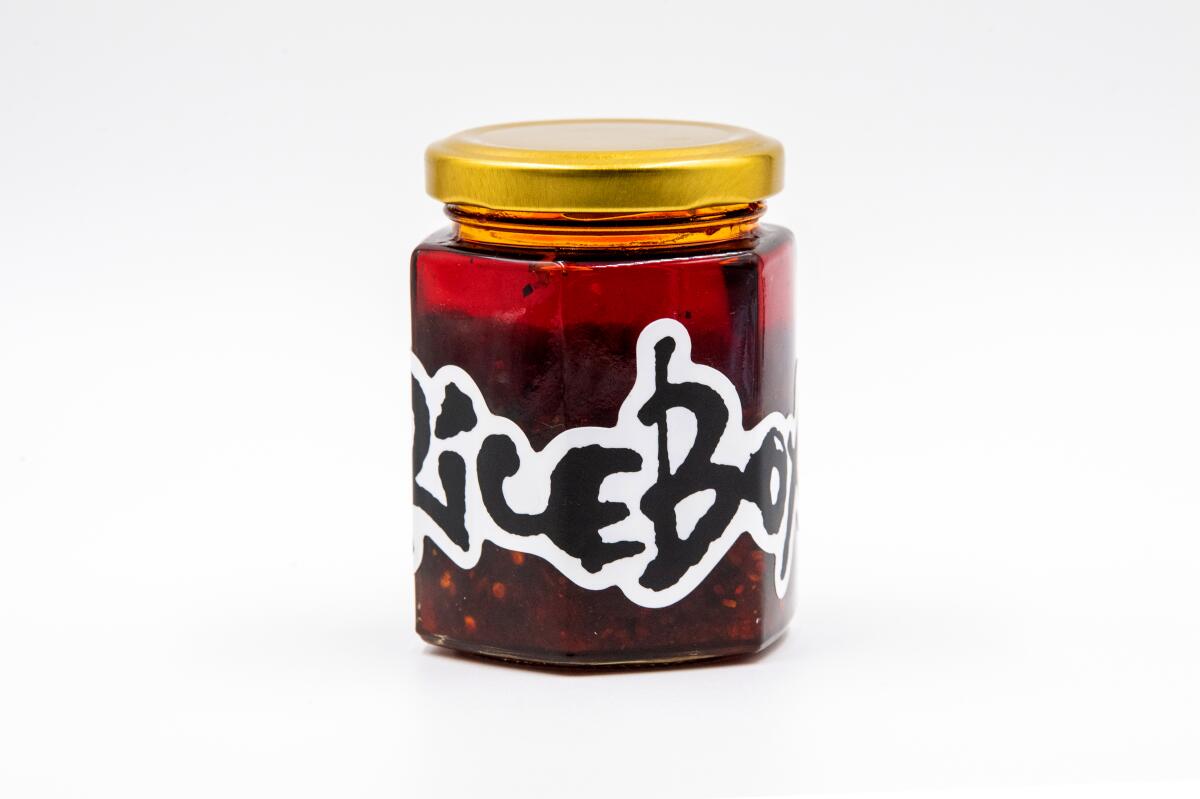
RiceBox owners Leo and Lydia Lee make about 20 quarts of chili oil a week, using a recipe passed down from Lydia’s grandfather in Hong Kong. It starts with dried chiles de arbol, dried chili flakes and powder, and Leo added Thai chiles for an extra kick of heat. The chiles are simmered in oil with garlic, soy sauce, salt and pepper for at least an hour, and then the infused oil sits overnight. Everything is finely incorporated into the oil, with no large pieces of chile flakes or garlic. The mouthfeel is soft and chewy, with a heat level around a 4 out of 10. The Lees started packaging the sauce in September after customers repeatedly requested larger quantities. “Honestly, I would recommend it on anything from chicken nuggets from McDonald’s to sandwiches and burgers,” Leo Lee said.
The Bits, $10
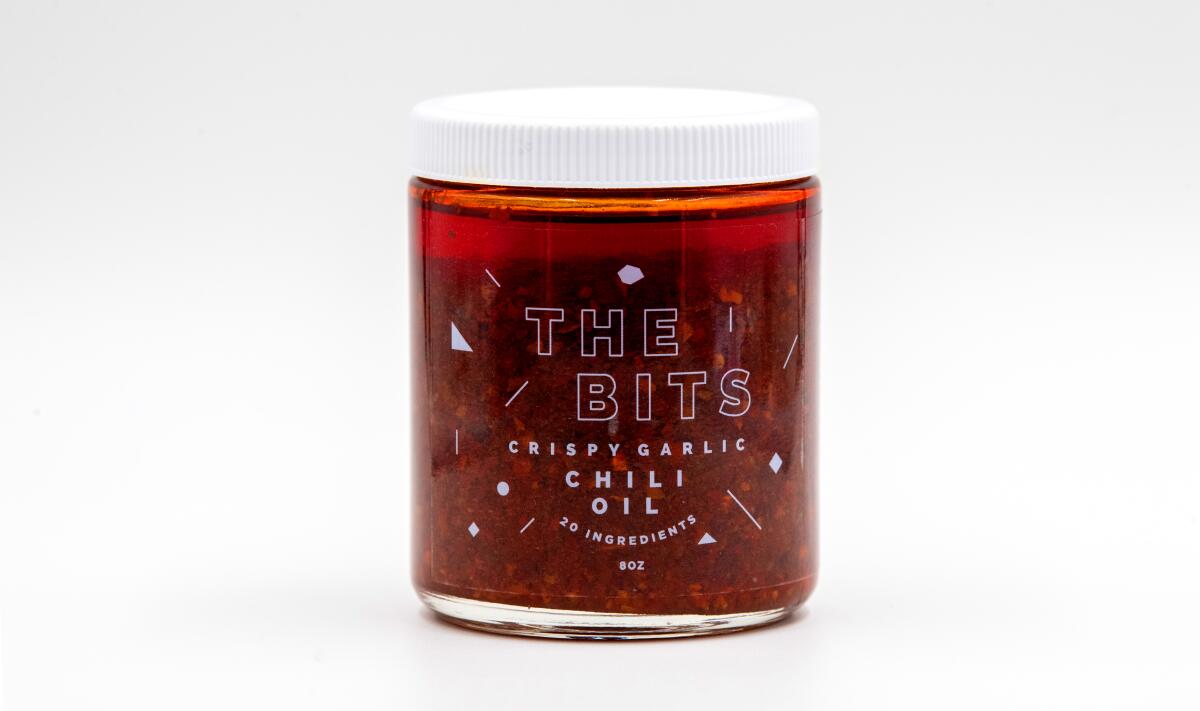
Susan and Mike Wong do not work in food. She works for an arts education nonprofit; he’s in sales operations for a tech company. But they both love spice, and the two started making chili oil last March. They looked up recipes online and tweaked their sauce numerous times before giving it to friends and family. Susan says the first iteration was similar in texture to Lao Gan Ma, coarse with whole Sichuan peppercorns. But the sauce gradually turned into more of a savory paste than a spicy oil. It’s fruity and funky, with fermented chili bean sauce, soy sauce, sesame oil, star anise, cardamom, cinnamon, bay leaves and lemongrass. The couple didn’t want to alienate people with a low spice tolerance, so the sauce comes in at about a 3 out of 10. The Wongs suggest putting it on everything, including pizza and burritos.
instagram.com/the.bits.chili.oil
Yang’s Kitchen chili crisp, $12
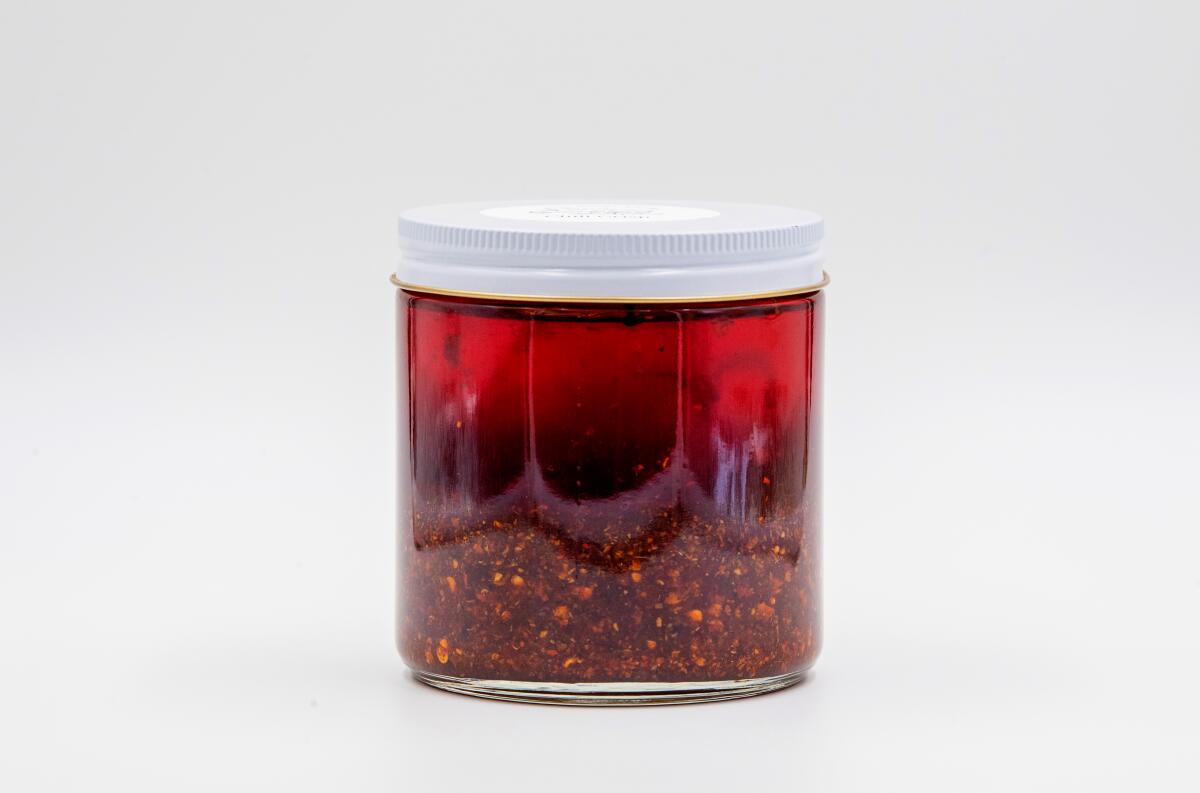
Christian Yang grew up eating at a lot of Asian restaurants in Los Angeles and abroad, and he always noticed a jar of chili oil on the tables. “Some were oil, some paste, some were more like sauces,” he said. “I just liked adding chile in general.” Between the stuff he jars and the sauce he serves, Yang goes through a lot of his own chili crisp at his Alhambra restaurant, using a recipe inspired by a family friend, who gave him some chili oil before Yang’s Kitchen opened in 2019. He uses Thai chiles, Japones chiles and chiles de arbol and plenty of fried garlic and shallots. When the restaurant reopened as a market after the initial pandemic shutdown in March 2020, he started selling jars of the chili crisp. Yang’s sauce is about half oil, half sediment, completely separated like a jar of natural peanut butter. You can taste the nuance of the ginger and the garlic, and the texture is grainy with nice crunchy bits throughout. The heat hits sharp and fast, and feels like a 6 out of 10.
Herbaceous. Fermented. Inspired by a decades-old recipe. Here are five local hot sauce varieties heating things up.
Ms. Chi Cafe chili crisp, $8
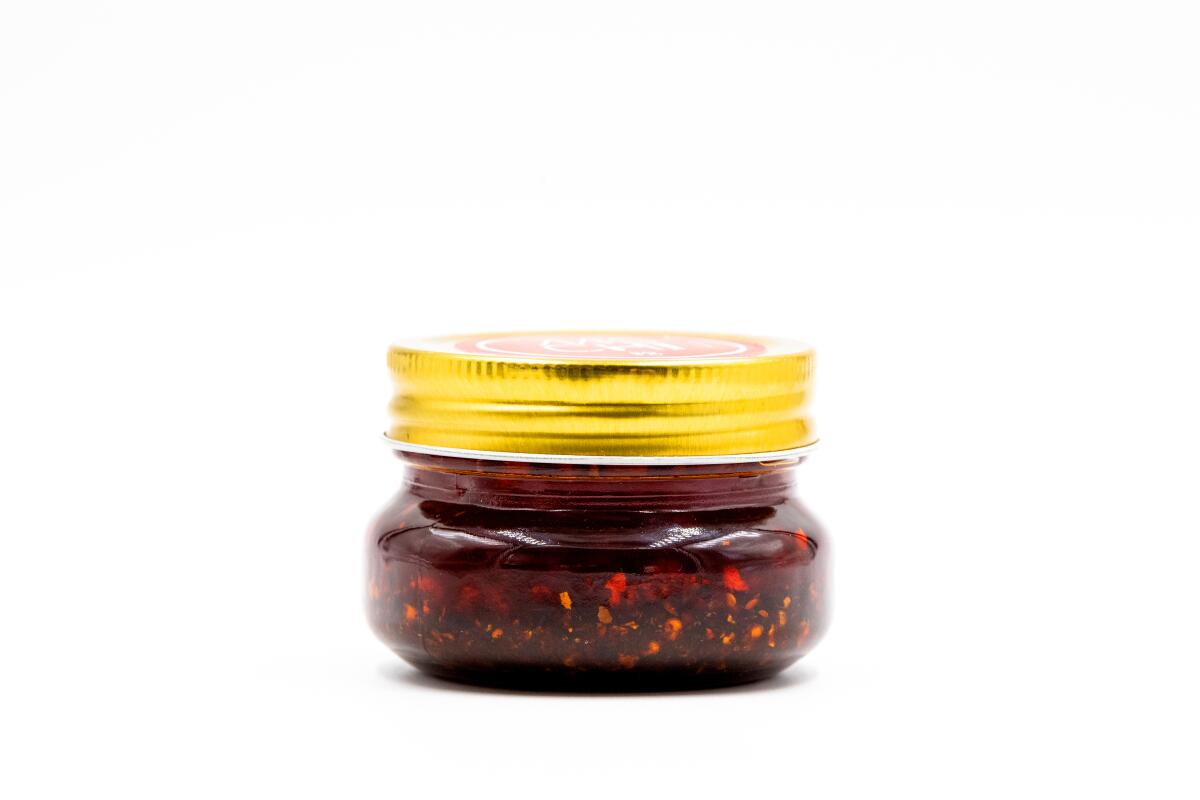
When Shirley Chung was the chef at Carnevino steakhouse in Las Vegas, Chinese tourists requested bottles of Lao Gan Ma for their steaks. Raised in Beijing, Chung was familiar with the sauce and bought some bottles to have at the restaurant. But it wasn’t until she spotted the sauce as a pantry ingredient during the 14th season of “Top Chef” in 2016 that she realized just how popular the sauce had become. Chung makes a chili crisp at her Culver City restaurant, Ms. Chi, offers it for free with the frozen dumplings she sells through Goldbelly, and uses it with her dumplings in chili oil dressing. After sending out “thousands of free containers” with her dumplings, she decided to bottle the sauce and sell it. Chung took a reductive approach, wanting to keep it similar to the chili crisp she grew up eating in Beijing. “It’s Chinese dry chile with Sichuan peppercorn, cayenne pepper from Louisiana and other dry chiles toasted in hot oil,” she said. The lack of garlic and other aromatics means the sauce is shelf-stable. It also means Chung’s crisp packs a wallop of pure chile that registers as a 7 or 8 out of 10.
Wax Apple chili sauce, $10
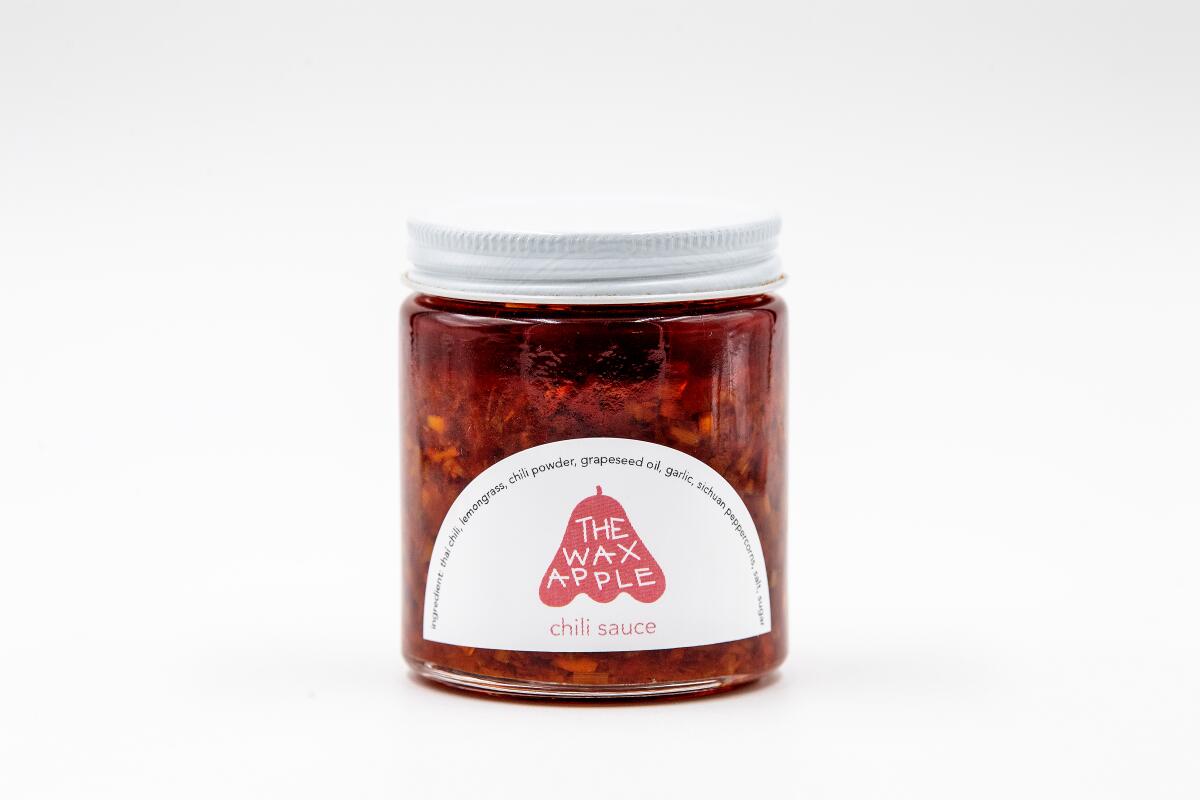
During one of her many trips back to Taiwan, Juliana Hung discovered a chile sauce made by a local chef’s mother, who made each batch by hand without a recipe. Back home in Los Angeles, Hung attempted to re-create the sauce and eventually came up with the formula she uses today. She makes hers by slowly frying garlic and lemongrass in grapeseed oil until golden and adding salt, sugar, ground Sichuan peppers, Thai chiles, Korean chile flakes and a little soy sauce. Satisfied with the results, she introduced her sauce to the pop-up dinners and cooking workshops she hosted out of her home. The sauce pingpongs between sweet and spicy with nubs of citrusy lemongrass and globs of jammy chopped chile. The heat is subtle (about a 2 out of 10) but accumulative. It sneaks up and leaves your lips tingling. It’s available in the Red Oil Collective box and online through the SoonMini website.
Strings of Life Fragrant Chilli Crisp, $14

At any given time, there are about 20 different bottles of hot sauce in Monty Koludrovic’s fridge — which attests to his love of heat. The culinary director for the Botanical group, which owns the Strings of Life Cafe and E.P. & L.P. restaurant and bar in West Hollywood, wanted to add a chile sauce to the pantry items available at the cafe. He said the Fragrant Chilli Crisp is a byproduct of a dan dan noodle sauce popular during staff meals at E.P. & L.P. He asked head chef Jordan Mathurin if he could make a version that was vegetarian, with an emphasis on the crispy bits of traditional chili crisp. The result is a sauce that requires a bit of muscle to wiggle your spoon through the tangle of crispy shallots, garlic and chile in the jar. It has a strong toasted-onion smell, and there are big, crunchy, discernible bits of fried shallot and garlic strewn throughout. The chiles pack a punch (it’s about a 6 out of 10) and the mala will linger.
ZinDrew crunchy garlic chili oil, $7
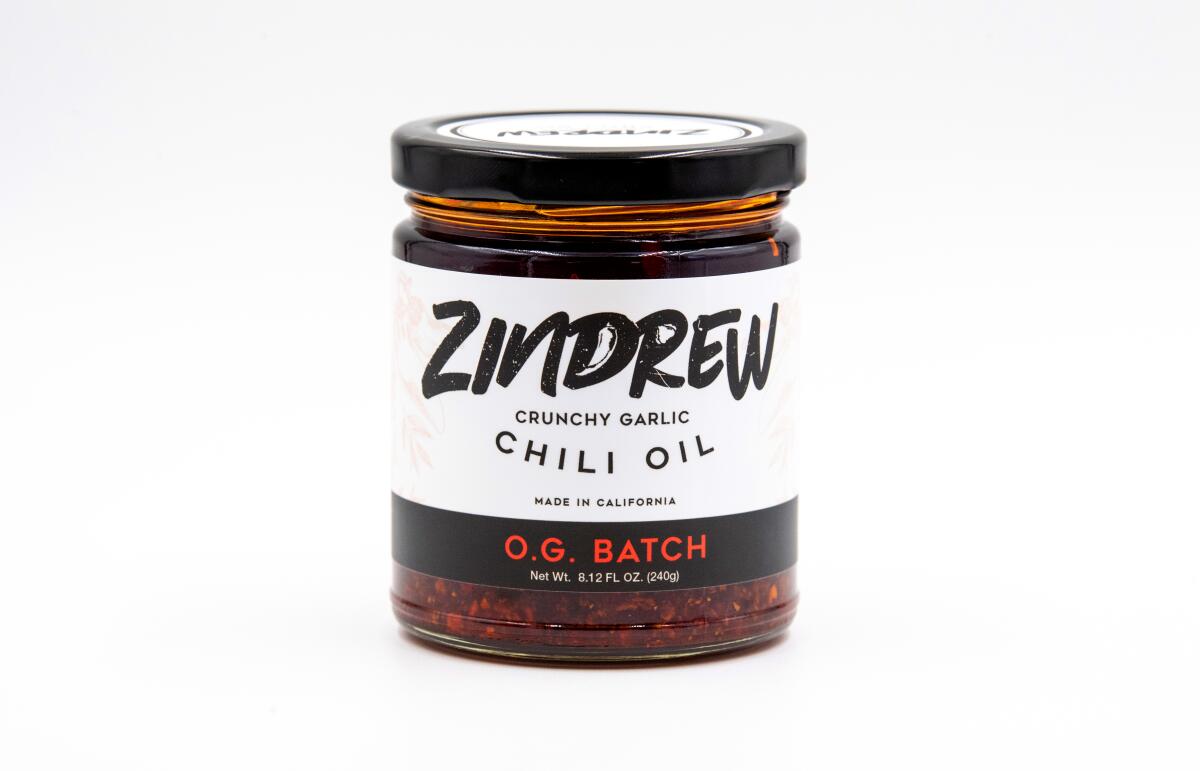
Zin Lee, a respiratory therapist for Kaiser Permanente, loves spicy food, but she was never satisfied with the chili oils she found at the market. Her husband, Andrew, a retired professional golfer, decided to surprise her and make his own. Zin didn’t like the fermented black beans, anchovies and Sichuan pepper in some of the sauces they tried, so Andrew left out those ingredients . He played up the fresh garlic and added brown sugar, sesame oil, Chinese Tianjin chiles, dried Korean chiles and MSG. The oil smells strongly of toasted garlic and chiles, and it’s more cohesive than others, with extra crunchy bits throughout. The heat level is about a 5, but if you like more spice, the Lees make an “X batch” that dials up the heat with Thai chiles. After giving the sauce to friends and family, they started selling jars in July 2019. Andrew hand-delivered the product, spending four to five hours a day delivering about 20 jars to customers in Southern California. Now they work with a packer in El Monte and sell about 3,500 to 4,000 jars a month.
More to Read
Eat your way across L.A.
Get our weekly Tasting Notes newsletter for reviews, news and more.
You may occasionally receive promotional content from the Los Angeles Times.
